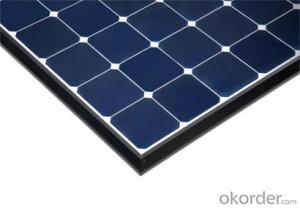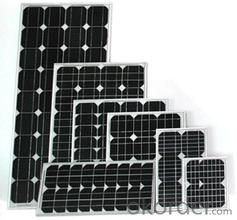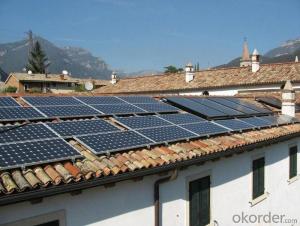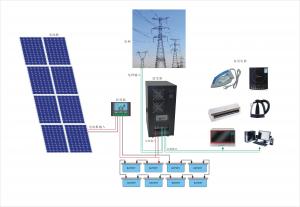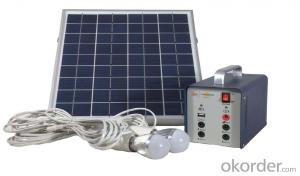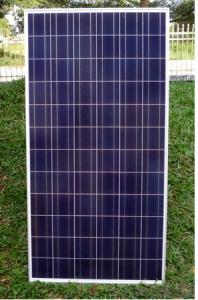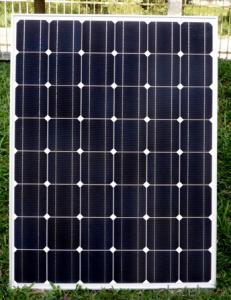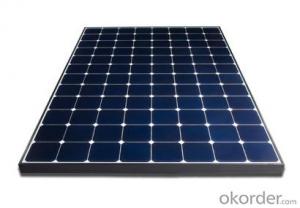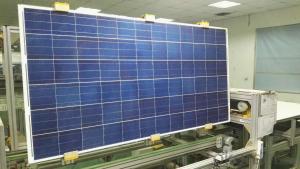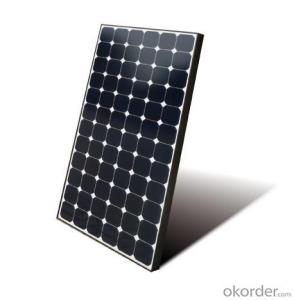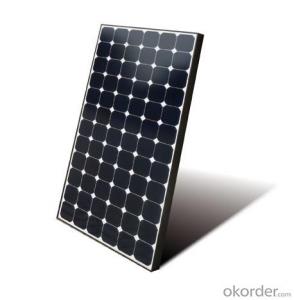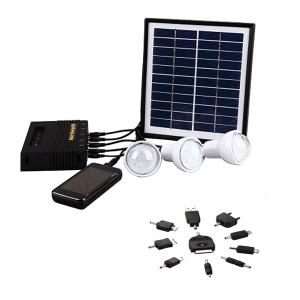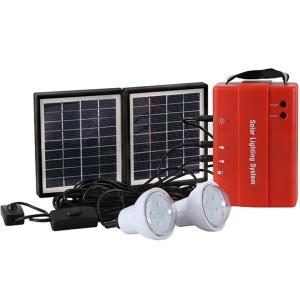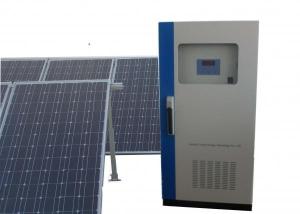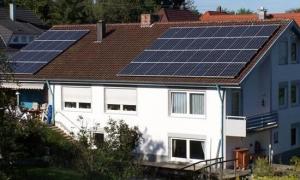Aditya Solar Energy Systems CNBM Poly 100W Off Grid Solar System with 10 Years Warranty
- Loading Port:
- Shanghai
- Payment Terms:
- TT OR LC
- Min Order Qty:
- 100 watt
- Supply Capability:
- 1000 watt/month
OKorder Service Pledge
OKorder Financial Service
You Might Also Like
Specification
CNBM Poly 100W Off Grid Solar Sytem with 10 Years Warranty
Product description
Electrical power can be generated on-site with renewable energy sources such as solar (particularly with photovoltaics), wind, micro hydro, geothermal; with a generator or Micro combined heat and power with adequate fuel reserves. Such a system is called a stand-alone power system. In addition, it is possible to simply eliminate electric power such as in Old Order Amish and Old Order Mennonitecommunities.
A recent concept design by Eric Wichman shows a multi-family community, which combines all of these technologies into one self-sufficient neighborhood. To grow the community you simply add neighborhoods using the same model as the first. A self-sustained community reduces its impact on the environment by controlling its waste and carbon footprint
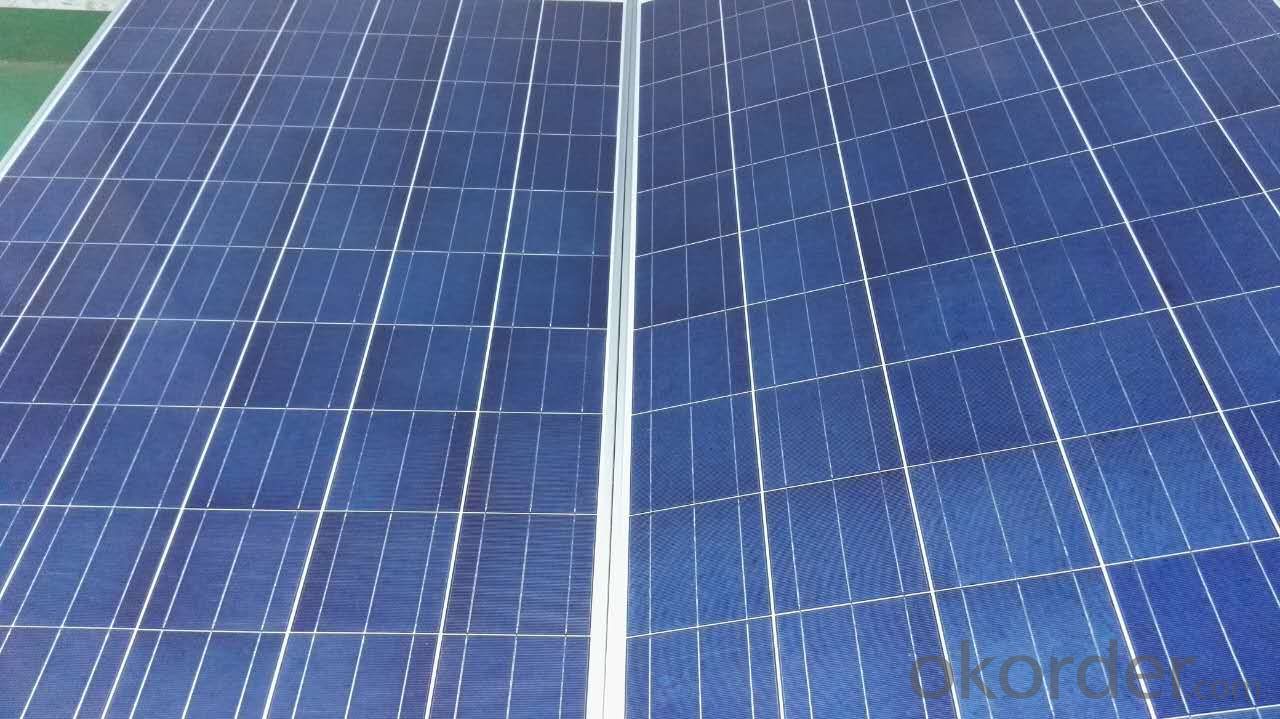
Application
Residential
Commercial
Industrial
Feature
Off-the-grid homes are autonomous; they do not rely on municipal water supply, sewer, natural gas, electrical power grid, or similar utility services. A true off-grid house is able to operate completely independently of all traditional public utility services. The idea has been recently popularized by certain celebrities including Ed Begley, Jr.[3] who stars in the Living with Ed[4] television show on the Home & Garden Television (HGTV) network. Actress Daryl Hannah promotes off-grid living and constructed her home in Colorado according to those principles, as does survival expert and Dual Survival co-star Cody Lundin,[5] who lives in a self-designed, passive solar earth house in the high-desert wilderness of Northern Arizona, collecting rainwater, composting waste, and paying nothing for utilities.[6][7]
Packaging
With carton and box
- Q: Can a solar energy system be installed on a building with a slate roof?
- Yes, a solar energy system can be installed on a building with a slate roof. The installation process may require extra care and expertise to ensure the integrity of the roof is maintained during the installation. It is recommended to consult with professionals who have experience in installing solar panels on slate roofs to ensure a proper and safe installation.
- Q: How does solar energy compare to other renewable energy sources like wind or hydro power?
- Solar energy, like wind and hydro power, is a crucial renewable energy source. However, it has its own unique advantages and disadvantages when compared to other renewables. Solar energy is abundant, easily accessible, and can be harnessed almost anywhere. While wind power may have the potential to generate more electricity, solar energy is more consistent and reliable. Similarly, hydro power is more efficient in terms of energy production, but it is limited by geographical constraints. Ultimately, the choice between these renewable sources depends on specific circumstances, such as location, available resources, and energy demands.
- Q: How do solar energy systems impact wildlife?
- Solar energy systems can have both positive and negative impacts on wildlife. On the positive side, they offer renewable energy, reducing the need for fossil fuels and reducing air and water pollution. Additionally, solar panels can provide shelter and shade for certain species. However, there are also negative impacts to consider. Large-scale solar projects can lead to habitat destruction, displacement of wildlife, and disruption of migration patterns. Additionally, the glare from solar panels can disorient birds and insects. To minimize these impacts, it is crucial to carefully plan and design solar projects, considering the needs and habitats of local wildlife.
- Q: What is the impact of bird nesting on solar panel efficiency?
- Bird nesting on solar panels can have a negative impact on their efficiency. The presence of nests can block sunlight from reaching the panels, reducing their ability to generate electricity. Additionally, birds may cause damage to the panels or wiring while building nests or perching, leading to further efficiency losses. Regular maintenance and deterrent measures are often needed to mitigate these issues and ensure optimal solar panel performance.
- Q: How much maintenance is required for a solar energy system?
- A solar energy system typically requires minimal maintenance. Routine maintenance involves cleaning the solar panels to remove any dust or debris and ensuring that the system is functioning optimally. Additionally, occasional inspections may be required to check for any potential issues or malfunctions. Overall, the maintenance requirements are relatively low, making solar energy systems a cost-effective and hassle-free choice for renewable energy.
- Q: Can solar energy systems be used for powering water pumps?
- Yes, solar energy systems can be used for powering water pumps. Solar-powered water pumps utilize photovoltaic panels to convert sunlight into electricity, which can then be used to run the pumps. These systems are especially useful in remote areas where access to electricity is limited.
- Q: What is the role of inverters in solar energy systems?
- The role of inverters in solar energy systems is to convert the direct current (DC) electricity produced by the solar panels into alternating current (AC) electricity that can be used to power homes and businesses. Inverters also ensure that the electricity generated by the solar panels is synchronized with the utility grid, allowing for any excess power to be fed back into the grid or stored in batteries.
- Q: Can solar energy systems be used in disaster-prone areas?
- Yes, solar energy systems can be used in disaster-prone areas. In fact, they can be particularly beneficial in such areas. Traditional power grids are often fragile and vulnerable to damage during natural disasters such as hurricanes, earthquakes, or floods. This can leave the affected areas without electricity for extended periods, hindering relief and recovery efforts. Solar energy systems, on the other hand, are decentralized and can operate independently of the grid. These systems consist of solar panels that convert sunlight into electricity, which can be stored in batteries for use during times of power outage. This allows critical facilities, such as hospitals, emergency response centers, and shelters, to continue functioning even when the grid is down. Solar energy systems can provide a reliable source of power for lighting, communication, refrigeration, and medical equipment, greatly enhancing the resilience and effectiveness of disaster response. Furthermore, solar energy systems can also be used to power water pumps, providing communities with access to clean water during times of crisis. This is particularly important in disaster-prone areas, where access to safe drinking water can be severely compromised. Solar-powered pumps can extract water from wells, rivers, or other sources, ensuring a constant supply for drinking, sanitation, and hygiene purposes. Additionally, solar energy systems can contribute to long-term recovery efforts in disaster-prone areas. By reducing dependence on fossil fuels and traditional power grids, they can help build more sustainable and resilient communities. Solar panels can be installed on rooftops or in open spaces, making use of abundant sunlight resources. This not only reduces greenhouse gas emissions and mitigates climate change but also provides a reliable and affordable source of energy for homes, businesses, and public infrastructure. In conclusion, solar energy systems can be effectively used in disaster-prone areas to provide reliable power, support critical services, and contribute to long-term resilience. By harnessing the power of the sun, these systems offer a sustainable and decentralized solution to energy needs, ensuring that communities can withstand and recover from natural disasters more effectively.
- Q: What are the different financing options for solar energy systems?
- There are several financing options available for solar energy systems. These include purchasing the system outright with cash or a loan, leasing the system, utilizing power purchase agreements (PPAs), and utilizing solar loans or solar-specific financing programs. Each option has its own benefits and considerations, such as upfront costs, ownership, maintenance responsibilities, and potential tax incentives. It is important to research and compare these options to determine the best fit for individual circumstances and financial goals.
- Q: Can solar energy systems be used for powering disaster relief operations?
- Solar energy systems have demonstrated their worth in disaster relief efforts, serving as a highly valuable means of supplying electricity to affected areas. The deployment of solar panels and solar-powered generators to regions struck by natural calamities enables the provision of a dependable and sustainable source of power. A key advantage of solar energy systems lies in their ability to operate autonomously, independent of the power grid. This proves especially beneficial in disaster situations where the power infrastructure may be damaged or utterly destroyed. Solar panels are capable of generating electricity even in remote locations, thereby allowing relief workers to access power for vital operations, such as communication, medical services, lighting, and water purification. Furthermore, solar energy systems offer cost-effectiveness and environmental friendliness. Once installed, solar panels require minimal maintenance, with sunlight serving as an abundant and free energy source. Consequently, there is no need for costly fuel deliveries or the utilization of expensive diesel generators, which can pose logistical challenges and financial burdens in areas ravaged by disasters. Additionally, solar power produces no harmful emissions, thereby reducing the impact on the environment and enhancing air quality in already vulnerable regions. Moreover, solar energy systems can be easily scaled up to meet the escalating power requirements of disaster relief missions. Temporary solar arrays can be rapidly established, and if necessary, additional panels can be incorporated into the system to generate more electricity. This flexibility empowers relief organizations to adapt and respond to the changing needs of the affected population. Nevertheless, it is crucial to acknowledge that solar energy systems may have certain limitations. Their effectiveness is contingent upon the availability of sunlight, which can be influenced by weather conditions or geographical factors. In regions with limited sunlight or during periods of cloud cover, the system's output may be diminished. To surmount this challenge, energy storage solutions, such as batteries, can be integrated into the system to store surplus energy for use during periods of low sunlight. In conclusion, solar energy systems have consistently demonstrated their reliability, cost-effectiveness, and sustainability in powering disaster relief operations. They offer electricity independently of the grid, mitigate environmental impact, and can be readily expanded. By harnessing solar power, relief organizations can efficiently deliver essential services to those in need, thereby facilitating a swift recovery process in disaster-stricken areas.
Send your message to us
Aditya Solar Energy Systems CNBM Poly 100W Off Grid Solar System with 10 Years Warranty
- Loading Port:
- Shanghai
- Payment Terms:
- TT OR LC
- Min Order Qty:
- 100 watt
- Supply Capability:
- 1000 watt/month
OKorder Service Pledge
OKorder Financial Service
Similar products
Hot products
Hot Searches
Related keywords
